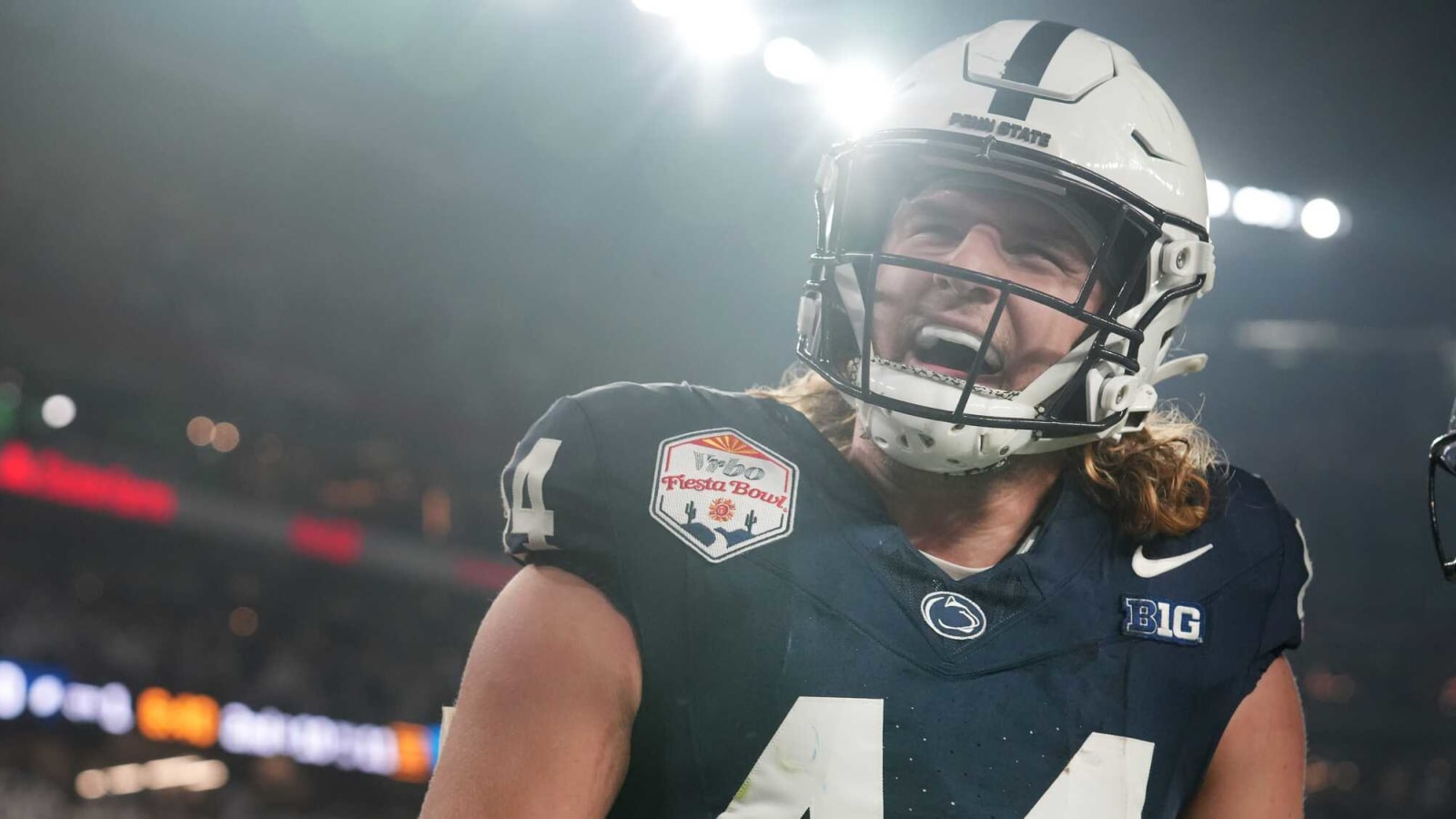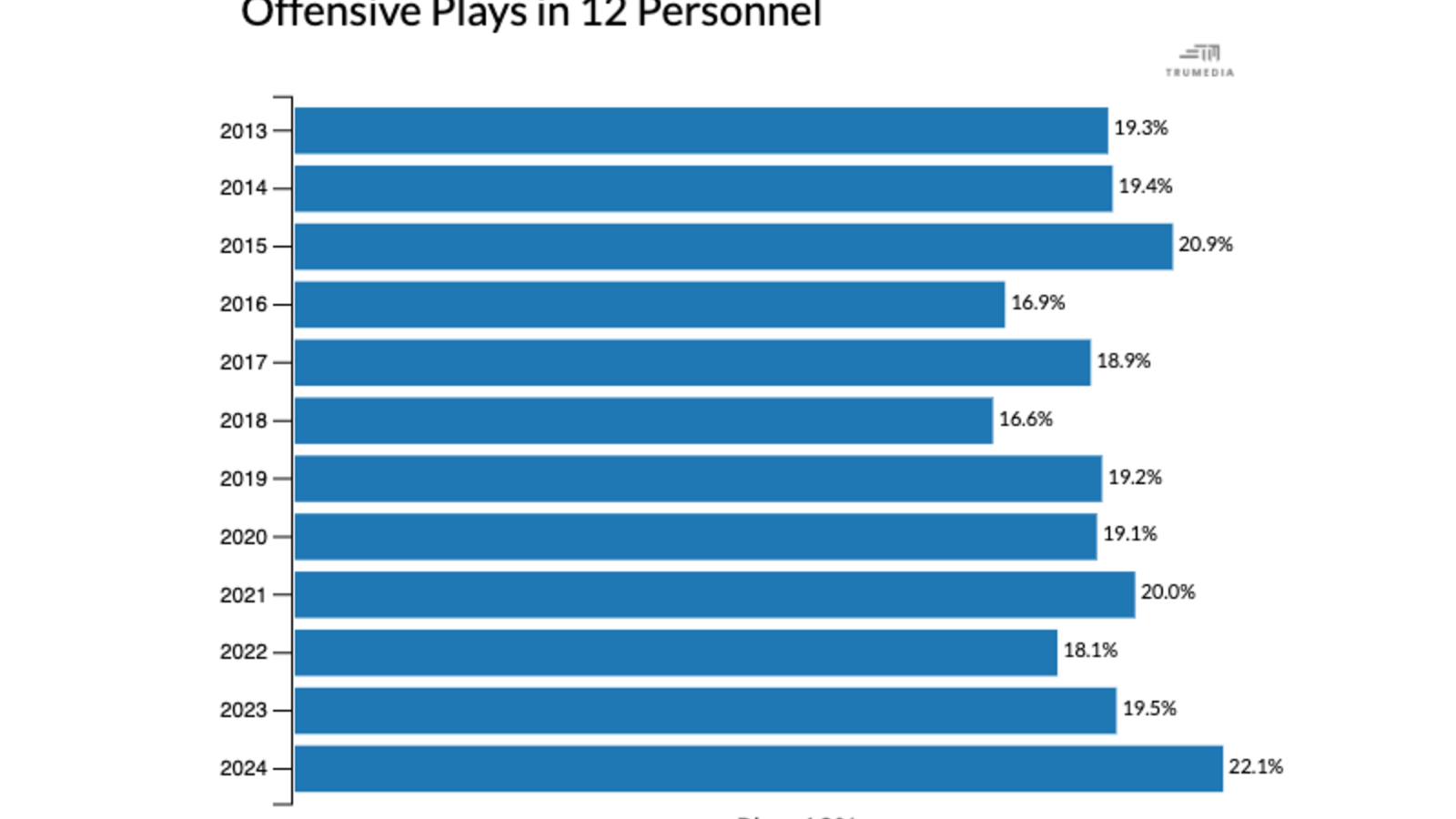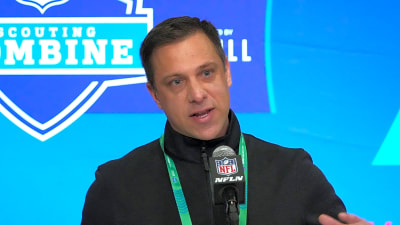
To play tight end successfully in the NFL is to master — or at least be competent at — multiple aspects of the offense.
You’re a great receiver? Cool, but will you be a net negative in the running game because you can’t block? Excel at blocking? That’s nice. Do you bring any value as a receiver?
Needing to manage heavy responsibilities in the run and pass games is one of the reasons tight end has been a historically slow development position for those entering the NFL. Players at tight end were more likely to break out during their second contracts — often for new teams — than they would in their rookie seasons.
That’s part of the reason tight ends have not often been selected in the first round. The timeline for getting a tight end to be a productive player does not always give teams the return on investments they are looking for with an early draft pick. But that might be starting to change.
We’re entering an era now where tight ends have become more useful in the passing game while offenses are getting better at playing to a tight end’s strengths. During the past five seasons, the league-wide target share for tight ends has risen, while the efficiency on those targets reached a five-year high in 2024.
Tight End Receiving Value, 2020-2024 (per TruMedia)
| Year | Target Share | EPA/Play | Success% |
| 2020 | 20.0% | 0.16 | 52.3% |
| 2021 | 20.2% | 0.16 | 51.5% |
| 2022 | 20.2% | 0.15 | 50.6% |
| 2023 | 20.4% | 0.17 | 51.4% |
| 2024 | 21.4% | 0.20 | 52.2% |
There’s value in those passes, and there’s also value in having a tight end as a big piece of a passing game. Before the Chiefs-49ers Super Bowl, we highlighted the contractual value of a tight end serving as a No. 1 receiver. That gap has widened.
Travis Kelce leads all tight ends and is making an average of $17.125 million per year on his most recent contract extension signed in 2024. That is less than the average value for Jerry Jeudy ($17.5 million), who is the 22nd-highest-paid wide receiver by AAV.
But this also isn’t a position like running back, where a highly drafted player immediately becomes one of the highest-paid players at the position. Brock Bowers, drafted 12th overall last year, still averages just $4.5 million per year. Luke Farrell — who has 36 career receptions in four seasons with the Jaguars — signed a three-year deal with the 49ers this offseason that averages $5.25 million per year.
Even Kyle Pitts, who has not lived up to his rookie year production and expectations as a former fourth-overall pick, will have a $10.9 million cap hit on his fifth-year option in 2025, which is 14th among tight ends for the upcoming season.
The rise in tight end usage comes on the heels of the emergence of a new era of tight ends. Kelce and Kittle are now into their 30s, but the young collection of tight ends is growing.
Bowers had an incredible rookie season and is likely to remain the Raiders’ top pass catcher. Sam LaPorta has been a big piece of the Detroit passing game. Trey McBride could have easily been an All-Pro selection last season. Tucker Kraft had 700 receiving yards and averaged 9.1 yards after the catch per reception in 2024.
Now, enter the 2025 tight end draft class. If last year gave us the golden age of wide receiver prospects, we might be there this year at tight end. We could have at least two first-round options with a deep class behind them.
What makes this tight end class potentially special is that there’s a bit of everything available for a league that is more willing to adapt to the player. As “tight end” is less of a one-size-fits-all position, teams are more likely to put these players into roles they shouldn’t be playing.
Some tight ends in this class can play and excel in the more traditional alignments. Others will play more as big slot receivers. The beauty and fit will be in the eye of the beholder.
Penn State’s Tyler Warren is viewed as the top player at the position because he can do everything and was often asked to do so at Penn State. Warren had a 32 percent target share in 2024, higher than any other tight end in this draft class outside of Bowling Green’s Harold Fannin Jr. (38.4 percent), according to TruMedia.
Warren spent 31 percent of his snaps in the slot and another 10 percent out wide. He has the physical presence to win as an inline tight end, both as a blocker and receiver, but his versatility is a big part of his game.
Not only could Warren move around the formation, but it was often a a key aspect of the Nittany Lions’ plan on a play level to get Warren moving to manipulate the defense.
He also was a force on screens, averaging 5.85 yards per route run with 158 yards on 20 targets. Warren had two receptions of 20 or more yards on screens during the 2024 season, while the rest of the tight end class combined for three.
Warren could slide into any offense and have a role. For that reason, he’s viewed as a fringe top-10 pick with an expected draft position of 11th and an overall rank of ninth, according to Grinding The Mocks.
The No. 2 tight end in the class is more of a receiver, Michigan’s Colston Loveland. Loveland played 33.6 percent of his snaps in the slot and 13.8 percent out wide. While he only ran 207 routes in 2024, he was targeted on a class-high 39.6 percent of them and averaged 2.86 yards per route run — third in this class.
Loveland didn’t test at the combine, but it’s clear he has movement skills that aren’t available to most 6-foot-6, 248-pound players.
By playing at Michigan, Loveland might have been in a more “pro-style” offense than he’ll be in the NFL. Because he has experience playing inline in that type of system, he won’t have to be a Mike Gesicki-type of slot player who doesn’t offer much more than routes from the slot. He’ll get to move around more often while still having the slot available to him.
Bowers played in the slot on 43.7 percent of his snaps as a rookie. Trey McBride was at 41.8 percent last season. Among NFL tight ends who ran at least 200 routes in 2024, the average slot rate was 31.5 percent. That rate topped 30 percent for the first time in 2023.
League-wide Average Tight End Alignment (per TruMedia)
| Year | Slot | Inline |
| 2020 | 27.0% | 59.2% |
| 2021 | 29.9% | 57.1% |
| 2022 | 29.0% | 57.9% |
| 2023 | 32.7% | 53.4% |
| 2024 | 31.5% | 54.6% |
While the receiving ability will be the main attraction, blocking acumen will continue to be the true differentiator and mismatch decider. If a tight end is just a great receiver, opposing defenses can still treat him like a receiver. But if the blocking is good enough for that player to be a threat in the run game and serve as that extra lineman, then defenses have to decide how to play those packages, whether in 11 or 12 personnel.
That’s typically where the development curve has been the biggest for tight ends coming into the league. There can be such a big menu of blocking responsibilities that taking those on overwhelms the player and reduces the impact in the passing game.
But with the intention of fitting players into roles suited for them, fewer tight ends should be asked to consistently be in over their heads as blockers.
Loveland, for example, had an astronomical 12.5 percent blown block rate as a pass blocker in 2024, according to Sports Info Solutions charting. However, he was an aggressive and willing run blocker, which led to just a 0.9 blown block rate on the ground. Asking Loveland to stay in and pass block often — he averaged just 1.8 pass-blocking reps per game — would diminish his impact in the passing game, but he could have an impact in the running game.
Meanwhile, a player like Mason Taylor of LSU could provide more value as a receiver to his NFL team due to how often he was asked to protect in college. Taylor, son of Hall of Famer Jason Taylor, had 79 targets in his final college season but averaged a class-high 9.3 pass-blocking snaps per game, nearly two more than the next-highest tight end. He averaged 9.0 per game through his three-year career.
If he serves as more of an H-back/slot role in the NFL, he won’t have to be in as a pass blocker so often, which should allow him to use more of his movement skills as a receiver.
The acceptable level of competency as a blocker could also shape the careers of players lower down the board, such as Olande Gadsden II from Syracuse. Gadsden is not viewed as a strong blocker, but he did not have a blown block in the passing game and had an average 1.1 percent blown block rate against the run, per SIS.
His lack of blocking prowess comes more from some functional strength and chosen angles, but that could be a place where NFL coaching could help. If he’s not a net negative as a blocker, he’s a player who has the receiving skills to be a mismatch in two tight end sets.
Currently, there are six tight ends in the top 100 of The Athletic’s version of the Consensus Big Board. Those players are Warren, Loveland, Taylor, Miami’s Elijah Arroyo, Texas’s Gunnar Helm, and Bowling Green’s Harold Fannin Jr.
There were eight tight ends drafted in the first 100 picks during the 2023 draft, with a ninth selected at pick 101. We could see that number challenged with this year’s class, one that runs deep with talent and a variety of player archetypes.
The NFL has embraced tight end usage with the highest rate of 12 personnel (22.1 percent in 2024) the league has seen since at least 2013.

This gives these types of players more opportunities to get on the field and serve in roles that best suit their abilities.
The NFL is crossing its best tight end usage with a draft class that could be the most talented we’ve seen in some time. A new wave of tight ends is approaching, and the league is more prepared than ever to allow those players to make their impact felt from the start.
More must-reads:
- Jakobi Meyers has changed Jaguars season, and now they paid him
- Tom Brady thinks he could do more than just follow Philip Rivers, return to NFL
- The 'NFL's active TD-catch leaders' quiz
Breaking News
Trending News
Customize Your Newsletter
 +
+
Get the latest news and rumors, customized to your favorite sports and teams. Emailed daily. Always free!








